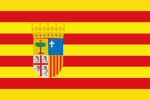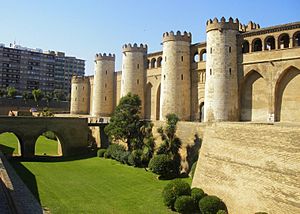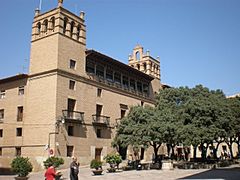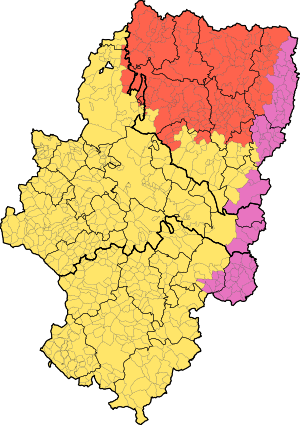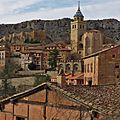Aragon facts for kids
Quick facts for kids Aragon (Aragón) |
|||
| Autonomous community (Comunidad autónoma) | |||
|
|||
| Official name: Comunidad Autónoma de Aragón | |||
| Country | |||
|---|---|---|---|
| Region | Iberian Peninsula | ||
| Capital and largest city | Zaragoza | ||
| - elevation | 7 m (23 ft) | ||
| - coordinates | 41°39′N 0°39′W / 41.650°N 0.650°W | ||
| Highest point | Aneto | ||
| - location | Ribagorza, Pyrenees, |
||
| - elevation | 3,404 m (11,168 ft) | ||
| - coordinates | 42°37′56″N 0°39′28″W / 42.63222°N 0.65778°W | ||
| Lowest point | Ebro | ||
| - location | Zaragoza, Ebro Valley, |
||
| - elevation | 65 m (213 ft) | ||
| - coordinates | 41°39′0″N 0°53′0″W / 41.65000°N 0.88333°W | ||
| Area | 47,719 km² (18,424 sq mi) | ||
| Population | 1,347,150 (2013) | ||
| Density | 28 /km² (73 /sq mi) | ||
| Statute of Autonomy | 10 August 1982 last revision April 2007 |
||
| President | Luisa Fernanda Rudi (Partido Popular) | ||
| Timezone | CET (UTC+1) | ||
| - summer (DST) | CEST (UTC+2) | ||
| ISO 3166-2 code | ES-AR | ||
| Demonym | Aragonese Spanish: Aragonés (sa) |
||
| Anthem | Himno de Aragón | ||
| Currency | Euro (€) | ||
| Date format | dd-mm-yyyy | ||
| Drive | right-side | ||
Aragon is an autonomous community in the northeast of Spain. In the various dialects of Spain it is: in Aragonese: Aragón; in Spanish: Aragón; in Catalan: Aragó.
Aragon covers the area of the medieval Kingdom of Aragon. It is named after the Aragón river, a tributary of the Ebro.
Aragon has three provinces (from north to south): Huesca, Zaragoza and Teruel. Its capital is Zaragoza (sometimes called Saragossa in English).
Contents
Geography
Aragon is one of the 17 Spanish autonomous communities. It has a surface area of 47,719 square kilometres (18,424 sq mi), 9.4 percent of the territory of Spain. By area, it is the fourth largest Spanish autonomous community after Castile and León, Andalusia and Castile-La Mancha.
Aragon is bordered to the north by France (Nouvelle-Aquitaine region). Within Spain, the community is bordered to the east by Catalonia (Lerida and Tarragona provinces), to the south by Valencian Community (Castellón and Valencia provinces) and Castile-La Mancha (Cuenca and Guadalajara provinces), and to the west by Castile and León (Soria province), La Rioja and Navarre.
Relief
Most of Aragon has an altitude of 201–3,404 m (659–11,168 ft). The highest point is the Aneto peak with 3,404 m (11,168 ft) high; it is the highest mountain of the Pyrenees.
The lowest point in Aragon is on the Ebro river, close to Zaragoza, with an altitude of 65 m (213 ft) high.
The three main geographical regions of Aragon are:
- The Aragonese Pyrenees has the highest points of this range that separates Spain from France. The main mountains are Aneto (3,404 m), the highest in the range, Posets Peak (3,375 m), Monte Perdido (3,355 m), Perdiguero (3,222 m), Cotiella (2,912 m), among others. The main Pyrenean valleys, formed by the rivers that are born there, are Ansó (Veral river), Hecho (Aragon Subordán river), Canfranc (Aragón river), Tena (Gállego river) and Broto-Ainsa-Benasque (Ara, Cinca and Ésera rivers). The Ordesa y Monte Perdido National Park lies above these valleys.
- Further south, the Ebro valley, irrigated by the Ebro river, is a rich and fertile agricultural area covered with vast fields of wheat, barley and other fruit and vegetable crops. Many beautiful and little-known settlements, castles and Roman ruins are found here.
- South of Zaragoza and the Ebro valley, the elevation rises again into the Sistema Ibérico, a complex system of mountain ranges that separates the Ebro valley from the Meseta Central and plains of Castile-La Mancha. The highest mountain in this range is the Moncayo with 2,314 m (7,592 ft).
Rivers
Most of the Aragonese rivers are tributaries of the Ebro, Spain's largest river in volume and which divides Aragon into two. Some important tributaries on the left side of the river (rivers that come from the Pyrenees) are the Aragón, born in Huesca but flows into the community of Navarre, the Gállego and Cinca, which joins the Segre just before ending up in the Ebro. Right tributaries are the rivers Jalón, Huerva and Guadalupe.
On the Ebro, near the border with Catalonia, lies the Mequinenza Reservoir, with a length of about 110 km, and that is popularly known as the Sea of Aragon.
Climate
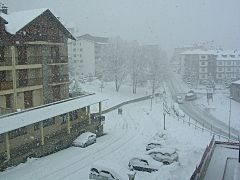
Climatically, Aragon can be divided into three areas:
- Continental Mediterranean. The Ebro valley. One of the severest climates in Spain and a daily and winter-summer temperature range. Low levels of rainfall which decrease as clouds move east towards Catalonia.
- Alpine-mountain climate. Short summers and very cold winters, though with big differences depending on altitude and orientation.
- Continental. The Calatayud-Daroca-Teruel region with mountains to the west and east that block the humid winds from the Atlantic Ocean and from the Mediterranean Sea. Low rainfall: 600–900 mm (24–35 in). Hot summers and very cold winters.
In the middle of Aragon, which is only 200 m (656 ft) above sea level, the annual average temperature is around 14 °C (57 °F). To the north and south of the Ebro valley, where the elevation rises to 500 m (1,640 ft) above sea level, the temperature drops by two degrees. In the mountains, between 600 and 1,000 m (1,969 and 3,281 ft), the temperatures are between 11 and 12 °C (52 and 54 °F).
Administrative divisions
Aragon consists of three provinces named after their capitals: Huesca, Teruel and Zaragoza. Each province is divided in comarcas (a comarca is a local administrative division) and these are divided in municipalities.
| Province | Capital | Population | Area (km2) |
Municipalities |
|---|---|---|---|---|
| Huesca | Huesca | 226,329 | 15,626 | 202 |
| Teruel | Teruel | 142,183 | 14,809 | 236 |
| Zaragoza | Zaragoza | 978,638 | 17,274 | 292 |
Population
Aragon has a population, in 2013, of 1,347,150, for a population density of 28.2 inhabitants/km2, one of the lowest in Spain. The most densely populated areas are around the valley of the Ebro river, particularly around Zaragoza, and in the Pyrenean s (the hills at the base of the Pyrenees), while the areas with the fewest inhabitants tend to be those that are higher up in the Pyrenean mountains, and in most of the southern province of Teruel.
The province of Zaragoza is the one with more inhabitants, with 978,638 people living there, representing 72.6% of the population of Aragon.
The city with more people living in it is the capital, Zaragoza (620,419). The other provincial capitals Huesca and Teruel have, respectively, 47,923 and 31,506 inhabitants.
Most important cities
The 10 most important cities in the department are:
| City | Population (2011) |
Province |
|---|---|---|
| Zaragoza | 620,419 | Zaragoza |
| Huesca | 47,923 | Huesca |
| Teruel | 31,506 | Teruel |
| Calatayud | 18,531 | Zaragoza |
| Ejea de los Caballeros | 16,183 | Zaragoza |
| Barbastro | 15,457 | Huesca |
| Alcañiz | 13,708 | Teruel |
| Fraga | 13,035 | Huesca |
| Jaca | 12,322 | Huesca |
Language
Spanish is the native language in most of Aragón. The only official language, it is understood and spoken by virtually everyone in the region.Also, Aragonese is still spoken, in several local varieties, in the mountainous northern counties of the Pyrenees, particularly in western Ribagorza, Sobrarbe, Jacetania and Somontano. In the easternmost areas of Aragón, along the border with Catalonia, varieties of Catalan are spoken, including the comarcas of eastern Ribagorza, La Litera, Bajo Cinca, Bajo Aragón-Caspe, Bajo Aragón and Matarraña.
Images for kids
-
Hermitage of la Virgen de la Peña in Aniés, La Sotonera, province of Huesca
-
Aneto peak is the highest point of all Pyrenees. It is located in the Posets–Maladeta Natural Park.
-
Abbey of San Pedro de Siresa, monastic, political and cultural center of the ancient County of Aragon, where Alfonso I was educated. It is located in the Hecho Pyrenean Valley.
-
Mallos de Riglos conglomerate rock formations, in Las Peñas de Riglos
-
Moncayo Massif seen from Tarazona. Moncayo, with its height of 2314.3 m, is the maximum summit of the Sistema Ibérico mountainous chain.
-
Formigal Ski Resort near Formigal town, Sallent de Gállego
-
Inside Ordesa Valley, of the Ordesa y Monte Perdido National Park
-
Bust of Augustus found in Tarazona
-
The Aljafería, of the 11th century, was residence of the Banu Hud kings of the Taifa of Saraqusta.
-
Castle of Loarre was built and expanded to serve as a frontier advance towards Muslim territories. It is one of the most important intact Romanesque castles in Europe.
-
Royal Monastery of San Juan de la Peña. In its Royal Pantheon a good number of kings of Aragon and some kings of Navarre are buried.
-
Aragonia Regnum, map of the Blaeu based on that of João Baptista Lavanha published circa 1640
-
1820 Emblem of the Political Government of Aragon under the Liberal Triennium (1820)
-
French troops storming the Abbey of Santa Engracia, February 1809, painted by Lejeune
-
Belchite town, destroyed during the Battle of Belchite, became a symbol of the Spanish Civil War.
-
General view of the Expo 2008 from the Torre del Agua
-
The Fragatina costume historical of Fraga
-
La Romareda, home ground of Real Zaragoza
-
La Plaza de Aragón square in Zaragoza, on Saint George's Day, with a flag of Aragon of flowers
-
Aínsa, Aínsa-Sobrarbe
-
Collegiate Church of Santa María la Mayor in Alquézar
-
Gothic murals of the Crypt of Santa María del Perdón of the Church of San Esteban in Sos del Rey Católico
-
Puerta Baja gate in Daroca
-
Citadel of Jaca in Jaca
-
Aerial view of Mequinenza
See also
 In Spanish: Aragón para niños
In Spanish: Aragón para niños


